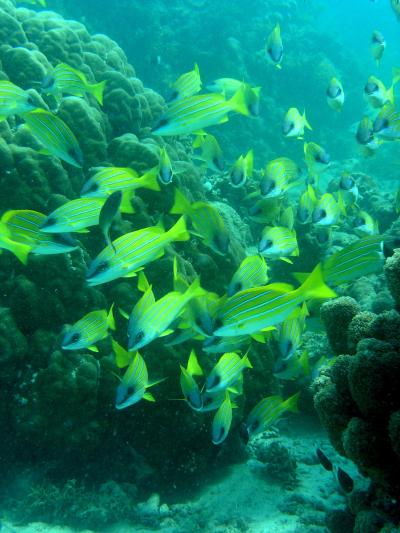Study finds marine protected areas inadequate for protecting fish and ocean ecology

A school of common bluestripe snappers in the waters off Kenya. A new study conducted by the Wildlife Conservation Society and other organizations reports that further expansion of marine protected areas is needed to protect fish species playing key ecological functions. Credit: Tim McClanahan
Many vital ecological functions of ocean ecology are performed by fish species that also are food for millions of people. This study uncovers a significant problem: the world's most ecologically valuable fish communities are currently vulnerable and are being missed by the world's current network of marine protected areas.
If these tropical fish populations and the ecological services that they provide are to be ensured, say the authors, then the world's existing marine protected area network must be expanded. The paper appears in the current online edition of Ecology Letters.
“The recognition that all species are not the same and that some play more important and different roles in ocean ecology prompted this new investigation. The study was expected to identify regions with vulnerable fish populations, something that has been sidetracked by the past species richness focus,” said Dr. Tim McClanahan, WCS Senior Conservationist and a co-author of the study.
“If you lose species with key functions, then you undermine the ability of the ocean to provide food and other ecological services, which is a wake up call to protect these vulnerable species and locations. Our analysis identifies these gaps and should provide the basis to accelerate the protection of ocean functions.”
The authors of the study compiled a global database on tropical coastal fish populations from 169 locations around the world, focusing on species occurring in 50 meters of water or less. The team compared these data with distribution maps for 6,316 tropical reef fish species. Human threats such as fishing, pollution, and climate change were also included in the analyses.
What the authors found was that many areas with threatened but functionally important fish were found outside of existing marine protected areas. Also, the study examined other vulnerabilities such as taxonomic sensitivity (the number of threatened species in a fish assemblage or community) and functional sensitivity (the number of functions in danger of being lost because of external threats).
From a regional perspective, the analysis revealed that species richness “hotspots” are located in the Indo-Australian Archipelago and the Caribbean. Species-rich areas for short-ranged fish were located in peripheral zones in the Atlantic as well as the Indo-Pacific.
Areas of high vulnerability included the coastal waters of Chile, the eastern tropical Pacific, and the eastern Atlantic Ocean, areas where comparatively few fish species perform vital environmental functions with few or no redundancies or species that fill similar roles.
“Protecting the ecological services that fish populations provide for coastal habitats is as important as protecting wildlife species themselves,” said Dr. Caleb McClennen, Executive Director of WCS's Marine Program. “This decision theory framework can help marine managers make recommendations about where to place marine protected areas that expand and protect the ocean's ability to provide key services.”
The authors of the study are: Valeriano Parravicini of the Institut de Recherche pour le Développement, Domaine du Petit Arbois, and the University of Perpignan; Sébastian Villéger of the Laboratoire Ecologie des Systèmes Marins Côtiers; Tim McClanahan of the Wildlife Conservation Society; Jesus Ernesto Arias-González of the Laboratorio de Ecología de Ecosistemas de Arrecifes Carolinos; David R. Bellwood of James Cook University; Jonathan Belmaker of Tel Aviv University; Pascale Chabanet of the Institut de Recherche pour le Développement; Sergio R. Floeter of the Universidade Federal de Santa Catarina; Alan M. Friedlander of the University of Hawaii at Manoa; François Guilhaumon of the Laboratoire Ecologie des Systèmes Marins Côtiers; Laurent Vigliola of the Institut de Recherche pour le Développement; Michel Kulbicki of the Institut de Recherche pour le Développement; and David Mouillot of the Laboratoire Ecologie des Systèmes Marins Côtiers and James Cook University.
Media Contact
More Information:
http://www.wcs.org/All latest news from the category: Ecology, The Environment and Conservation
This complex theme deals primarily with interactions between organisms and the environmental factors that impact them, but to a greater extent between individual inanimate environmental factors.
innovations-report offers informative reports and articles on topics such as climate protection, landscape conservation, ecological systems, wildlife and nature parks and ecosystem efficiency and balance.
Newest articles

Development of climate-neutral building materials
…through biogenic production using phototrophic microorganisms. The Fraunhofer Institute FEP in Dresden offers scalable research and development opportunities focused on technological innovations for resource conservation and climate neutrality. To meet…

New antibiotic producers described
Old DSMZ treasures with new potential. Researchers name newly described bacteria exclusively after female scientists. Researchers led by Dr Imen Nouioui and Prof. Dr Yvonne Mast from the Department Bioresources…

Nerve cells of blind mice retain their visual function
Nerve cells in the retina were analysed at TU Wien (Vienna) using microelectrodes. They show astonishingly stable behavior – good news for retina implants. The retina is often referred to…



